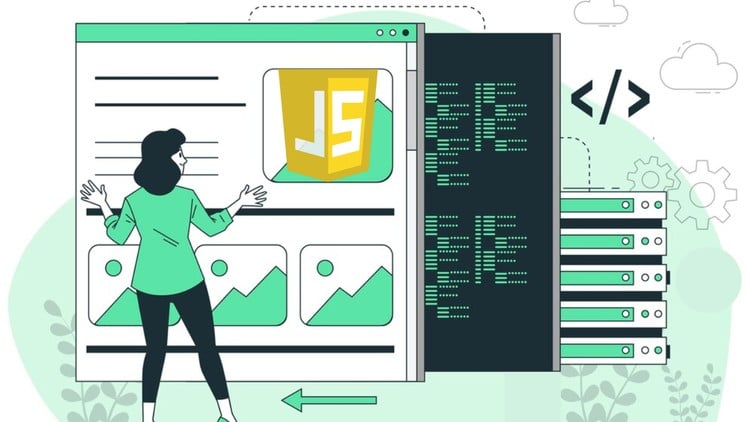
Learn advanced JavaScript concepts, Functional Programming, Async Workflows, Sets, Maps, Proxy, Reflect, Optimization…
What you will learn
Learn advanced programming concepts and applications of JavaScript.
Master higher-order functions and their applications in functional programming.
Utilize JavaScript closures effectively in real-world scenarios.
Implement advanced functional programming concepts such as currying, immutability, and pure functions.
Develop proficiency in recursion, tail recursion optimization, and sorting/searching algorithms.
Understand prototype-based inheritance and modern ES6+ class syntax for object-oriented programming.
Create reusable code using mixins, subclasses, and private fields/methods in JavaScript classes.
Handle asynchronous workflows using promises, async/await, and async iterators.
Debug and optimize JavaScript performance with tools like browser developer tools and memory management techniques.
Improve code efficiency using destructuring, rest/spread operators, and template literals.
Leverage advanced JavaScript features like Sets, Maps, Proxy, Reflect, and modules for better development practices.
Build and test scalable JavaScript applications with reusable components, Jest, and Mocha.
Apply design patterns, coding standards, and linting tools for cleaner, maintainable code.
Integrate RESTful APIs and handle data streams securely and efficiently with Fetch API, Axios, and JSON.
Optimize loops, operations, and memory usage for large datasets and high-performance applications.
Gain confidence in handling advanced interview questions and developing real-world projects to consolidate skills.
Why take this course?
Based on the comprehensive outline you’ve provided, this course seems to cover a wide range of advanced concepts in JavaScript. Here’s a structured approach to creating content or teaching material for each section:
Note➛ Make sure your 𝐔𝐝𝐞𝐦𝐲 cart has only this course you're going to enroll it now, Remove all other courses from the 𝐔𝐝𝐞𝐦𝐲 cart before Enrolling!
Section 1: Introduction to Advanced JavaScript
- Overview: Introduce the scope and objectives of the course.
- Prerequisites: Outline what students should know before starting the course (e.g., intermediate JavaScript knowledge).
Section 2: Course Structure
- Learning Objectives: Define what students will be able to do after completing each section.
- Assessment Plan: Explain how progress will be measured and assessed throughout the course.
Section 3: Course Materials
- Resources: Provide recommended resources for further reading and understanding of advanced JavaScript concepts.
- Community Support: Discuss where students can seek help (forums, chat groups, etc.).
Section 4: Course Schedule
- Timeline: Outline a timeline or suggested pace for completing the course.
- Milestones: Set key milestones or checkpoints to track student progress.
Section 5: Course Review and Practice
- Recap of Topics: Offer a review session summarizing all the advanced concepts covered.
- Practice Problems: Provide coding problems or projects that apply advanced JavaScript concepts in real-world scenarios.
Section 6: Course Projects
- Capstone Project Breakdown: Guide students through planning and executing their capstone project, ensuring it covers all aspects of advanced JavaScript.
- Project Peer Reviews: Set up a system where students can review each other’s projects and provide constructive feedback.
Section 7: Advanced JavaScript Topics
Section 1: Course Introduction and Prerequisites
- Course Overview: Explain the importance of advanced JavaScript in modern web development.
- Prerequisites: List the required knowledge for the course.
Section 2: Programming Paradigms (Declarative vs Imperative)
- Comparing Paradigms: Discuss the differences and use cases for both paradigms.
- Exercises: Provide examples that demonstrate the two paradigms.
Section 3: Design Patterns in JavaScript
- Common Patterns: Introduce common design patterns used in JavaScript (e.g., Module, Singleton, Observer).
- Implementing Patterns: Guide students through implementing these patterns with code examples.
Section 4: Coding Standards and Linting in JavaScript
- Code Quality: Discuss the importance of writing clean, readable, and maintainable code.
- Linting Tools: Introduce ESLint and other linting tools, explaining how to configure them and use them for code analysis.
Section 5: Testing JavaScript Code with Jest and Mocha
- Unit Testing: Explain the concept of unit testing and its importance.
- Test Frameworks: Teach students how to write tests using Jest and Mocha, covering test suites and assertions.
Section 6: Completing Practical Applications and Projects
- Building Components: Provide a step-by-step tutorial on creating reusable components with JavaScript in frameworks like React and Vue.
- Expense Tracker App: Offer a detailed project outline for an expense tracker app, encouraging students to implement advanced features.
Section 7: Advanced JavaScript Features
- JavaScript Sets and Maps: Teach the use of Sets and Maps for efficient data operations.
- Template Literals and Tagged Templates: Demonstrate how to use template literals and tagged templates for dynamic string creation.
- Destructuring and Rest-Spread Operators: Explain how to simplify code using advanced JavaScript operators.
Section 8: Patterns, Testing, and Standards
- Promises in JavaScript: Dive deep into understanding and working with promises.
- Error Handling: Cover creating and extending custom error objects, error propagation, and rethrowing errors.
- Memory Management: Discuss techniques to optimize memory usage in JavaScript applications.
Section 9: Interview Preparation for Advanced JavaScript Topics
- Interview Practice: Provide practice questions and answers, focusing on critical thinking and problem-solving aspects of advanced JavaScript concepts.
Section 10: Course Conclusion
- Recap of Key Points: Summarize the main takeaways from each section.
- Additional Resources: Recommend further reading or courses for topics that students found particularly challenging.
- Final Assessment and Feedback: Offer a final assessment to ensure understanding and readiness. Include feedback mechanisms for course improvement.
Additional Considerations:
- Assignment Submission: Set up a system for submitting assignments, whether it’s through an online platform or email.
- Feedback Loop: Establish a regular feedback loop where students receive constructive criticism and guidance.
- Community Engagement: Encourage peer learning and discussion through forums, coding challenges, and group projects.
- Accessibility: Ensure that all course materials are accessible to students with disabilities (e.g., transcripts for videos).
By structuring the course in this manner, you can provide a comprehensive learning experience that covers both theoretical and practical aspects of advanced JavaScript.
English
language
Found It Free? Share It Fast!